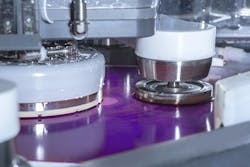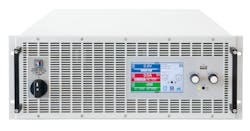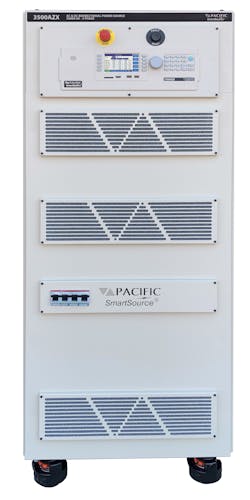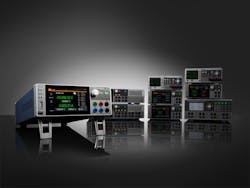Download this article in .PDF format
Advanced power solutions are at the heart of the current electronics revolution. With all of the advances in areas such as microcontroller design and machine learning, among others, the advent of significantly improved power systems to better drive these functionalities is a major development in the industry. These advances also mean challenges to the power test and evaluation industry. This Special Report on Power Test lists some interesting solutions.
SiC Wafer Qualification
Wide-bandgap materials like Gallium Nitride (GaN) and SIlicon Carbide (SiC) are already changing the world with performance several times better than that of Silicon. SiC, for example, has risen as the material of choice in advanced power systems such as those found in next-gen electric vehicles and industrial systems. One of the important enablers of this transition is that SiC chips are transitioning to larger, 200mm wafers that enable the chip counts to meet growing global demand.
When we approached Sundar Ramamurthy, Group Vice President and General Manager of the ICAPS group at Applied Materials, he talked about their latest products that are aiding the transition from 150mm to 200mm wafer production, which will approximately double the die output per wafer. Advanced materials engineering is needed to optimize raw wafers for production and build circuits with minimum damage to the crystal lattice. Sundar pointed out how the industry is now in the early stages of the SiC power revolution and will benefit from Applied’s expertise in materials engineering at an industrial scale.
Sundar pointed out that since SiC wafer surface quality is critically important to SiC device fabrication, it is important to address defects on the surface of the wafer, as they will migrate through the subsequent layers. To produce uniform wafers with the highest quality surfaces, Applied has developed the Mirra Durum CMP system which integrates polishing, measurement of material removal, cleaning, and drying in a single system. The solution results in a 50X reduction in final surface roughness as compared to mechanically ground SiC wafers and a 3X reduction in roughness compared to batch CMP processing systems.
The process of ion implantation places dopants within the material to help enable and direct the flow of current within the high-power-producing circuits. The density and hardness of SiC makes it very hard to inject and accurately place and activate the dopants while minimizing damage to the crystal lattice. Applied’s VIISta 900 3D hot ion implant system injects ions with minimal damage to the lattice structure, resulting in a more than 40X reduction in resistivity, compared to legacy processes at room temperature.
Addressing higher voltages and loads
When we spoke with Zeke Pietsch, Customer Success Manager at EA Elektro-Automatik, said that a major challenge for testing high-power consumer products today is working with higher voltages and load currents. As end-product power levels rise, manufacturers need to contend with higher power supplies and loads. Traditionally, a high voltage supply was a 1000 V supply. Now test engineers need to work with power supplies and loads with voltage ratings of 2000 V and higher.
In addition, test engineers have the challenge of minimizing test system cost and space. Supplies and loads with autoranging characteristics enable use of one supply or load to source or sink a much wider range of voltages and currents than a conventional supply or load with rectangular output characteristics. An autoranging source or load can reduce the number of high-cost, high-power supplies and loads. Furthermore, use of regenerative loads can save utility costs. If the source and load can be combined, then fewer devices are needed in the test rack, saving space and reducing control complexity.
Wideband semiconductors incorporated in new power supplies and loads have the potential to enhance testing of legacy systems and improve reliability with improved detection of defective and borderline defective products. Designs can be stressed more in accelerated life testing with power sources with higher voltage and current supplies and loads. The wide bandgap power components permit increased power density in enclosures that housed lower power, less-efficient sources and loads. Use of wideband semiconductors enables more thorough testing with function generators that can operate on top of high voltage supplies and loads. The function generators can simulate conditions on DC power lines and simulate varying conditions on electronic loads.
EA Elektro-Automatik offers dense, high-power supplies and electronic loads that have 30 kW capacity in only 4U high by full-rack width enclosures. These power handling devices can easily scale with as many as 64 parallel units to manage up to 1920 kW total power capacity. The ELR-series Programmable Electronic DC Loads are regenerative devices that provide 95% efficiency to both reduce power consumption and save utility costs. Reduced energy consumption saves on cooling infrastructure since much less energy is converted into the heat generated by a conventional load.
EA’s PSB-series Programmable Bidirectional DC Power Supplies offer two-quadrant operation combining up to 30 kW sourcing and loading. When a test system needs sourcing and loading at different times, the PSB-series two-quadrant supplies can save costs and test system rack space with use of a single instrument.
Both the PSB- and ELR-series instruments have a built-in arbitrary function generator that can enable test engineers to create load profiles to simulate loads such as solar cell inverters and loads for battery discharge testing under different conditions. Test engineers can simulate batteries, solar cells, and fuel cells with the power supply functionality of the PSB. Test engineers can also simulate noise and voltage variations on DC source lines.
The PSB-series and ELR-series instruments employ autoranging to permit test engineers to use a wider range of current and voltage compared with conventional rectangular-characteristic supplies and loads. This allows a wider range of DUTs to be tested with a single power supply. Furthermore, these instruments allow full power output or loading across a wide range of voltage and current settings. These instruments have a wide range of standard and optional interfaces which give the test engineer maximum flexibility to interface with PLCs (ModBus, Profibus), PCs (USB, Ethernet), and automotive controls (CAN bus).
Empowering the EV charging infrastructure
Herman vanEijkelenburg, Director of Marketing Pacific Power told us about the need to build a better and more expansive Electric Vehicle charging infrastructure, which increases the need to test on-board chargers, from home Level 1 and 2 chargers as well as Level 2 and 3 Public charging stations. Many on-board and in-home EV chargers are bidirectional to support peak demand shaving through V2G or V2H type use. This is pushing test requirements for power levels and voltages ever higher, both AC and DC.
He also pointed out that wide-bandgap semiconductor devices like GaN and SiC allow designs with higher energy efficiency and are able to handle higher device temperatures but do not fundamentally change the way power products are tested. The same programmable AC and DC power sources and electronic loads are generally capable of testing power products using conventional silicon as well as Wide bandgap-based designs.
PPST Solutions offers a wide range of power test equipment spanning power levels from as little as 500VA all the way up to 400kVA and higher as needed. This includes both programmable AC Source, DC Power Supplies and Electronic loads. The range of product types and power levels allows the company to tailor optimal power test solutions for their customers, which range from small startups to large established consumer and industrial companies.
For example, to address the need for range extending higher power battery packs for electric vehicles, we now offer regenerative AC power, DC power and electronic load power test equipment in a single unit. The new Pacific Power Source AZX Series regenerative AC & DC Source with optional load combines multiple test capabilities in a single product offering maximum flexibility to our customers. Starting at 30kVA/kW, these units are easily scalable to 400kVA/kW and offer advanced transient programming and high-speed data acquisition features as well as support for Power Hardware in the Loop (PHIL) applications.
Efficiency is important
When we reached out to our friends at Rohde & Schwarz, they pointed out how efficiency is key for all modern consumer products, be they battery-powered or connected to the grid. Besides optimally using and converting energy, efficiency also implies maximized uptime, e.g. by accelerating charging cycles. To achieve this, operational, idle and sleep states are employed on the one hand, and new standards like USB power delivery are used on the other. For both aspects, devices not only have to be tested with higher resolution and accuracy in voltage, current and time, but also with increased dynamic ranges.
For example, when engineering a Bluetooth low energy device, during the sleep state currents can fall below 1µA, and during charging currents can go up to 6A. In addition, to determine consumed power correctly, precise timing of the measurement is needed to distinguish between different operational states. Addressing both with one power supply is only possible with advanced DC power supplies like the specialty power supplies like the ones from Rohde and Schwarz. These offer up to 8 A sourcing and sinking, and a resolution down to 100 pA. Furthermore, they can resolve processes on a 2µs raster. In addition, power supplies that have a battery simulation feature, like the R&SNGM and the R&SNGU enable engineers to tune the circuitry under different battery charging states and other factors like ambient temperature.
Rohde & Schwarz provides high-quality T&M equipment for all phases of power electronic equipment measurements, covering design to delivery and into the field, with both passive and active components, tested along with complete device service and maintenance. When selecting suitable passive and active components in the early development phases, an LCR meter is ideal for assessing capacitors and inductors.
On a bench or in a test system, a versatile DC power supply portfolio with different power ratings, features and precision levels offers the right choice for each application. Multiple independent outputs provide separate power levels and characteristics, saving cost and space on the bench or in system racks. Both parallel and serial operation provides higher currents or voltages and covers more applications. Remote control is supported by a variety of interfaces. Programmable safety functions protect the DUT and instrument. Sophisticated features, such as battery simulation output delays, remote sensing, and data logging, speed up everyday measurements.





